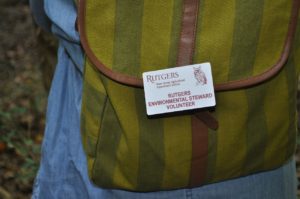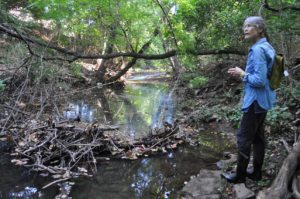Rutgers Environmental Stewards Champion the LRW
Photos and article by Michele Bakacs, Environmental and Resource Management Agent, Cooperative Extension of Middlesex County, Rutgers New Jersey Agricultural Experiment Station
Through a relatively new program sponsored by Rutgers University Cooperative Extension, citizens throughout the Lower Raritan Watershed are working to help people discover the hidden natural world flowing through their communities. These citizens are part of the Rutgers Environmental Steward program and their projects range from conducting stream habitat assessments to developing middle school illustration lessons highlighting the flora and fauna of the watershed.
The goal of the Rutgers Environmental Steward program is to help citizens understand the science behind pressing environmental issues and help create positive environmental change in their communities. Susan Edmunds from Highland Park is one such Environmental Steward working on assessing the health of Mill Brook, a tributary of the Lower Raritan River.
“My goal is to bring an awareness of the Mill Brook to the community so we can work to protect it and use it as an asset. I have realized the most important thing to do is just talk to people about the brook. So many people just don’t know it is there. It would be nice to be able to take a stroll along the brook in some of the already existing parks.”
One morning in September, we scramble down a steep ravine and climb down over branches to the brook. The brook is hidden behind chain link fences, railroad overpasses, and overgrown vegetation. Once you are there you can’t believe how beautiful it is. We are transported to a natural world where the gurgling stream winds its way past towering locusts and silver maple canopy trees, and through sandstone and shale outcrops. Of course we see garbage and dumping typical of every urban waterway- the stereotypical abandoned tire and shopping cart, down trees across the stream collecting trash showing you just how damaging plastic water bottles can be to our environment when not disposed of properly. But except for the occasional train coming by as a reminder, you can barely tell how close we are to houses, roads, and train tracks. There’s the sounds of birds, leaves blowing, shadows and sunlight peaking through the trees on the water. The brook is a hidden gem waiting to be discovered by anyone who makes the effort to find it.
“The Environmental Stewards program was exactly what I hoped it would be in that I gave me a way to start getting involved with environmental protection in my community.”
Environmental Steward Susan Edmunds Assesses Mill Brook
Mapping Mill Brook is the project Susan chose for her Rutgers Environmental Steward internship. After attending about 60 hours of classes that start in January and run through June, Stewards complete an internship project of their choosing in order to become a certified Rutgers Environmental Stewards. The program welcomes non-scientists and links them with members of the academic community, government, and non-profits. The curriculum includes classes, field trips, and an internship. Once Susan is done mapping her section of Mill Brook she will summarize her findings for the Lower Raritan Watershed Partnership who will use her work to prioritize sections of the Lower Raritan for monitoring, restoration, and clean up.
“Already this project has connected me with so many people who are just like me in that they want to clean up this stream. From this assessment I plan to create a presentation about the brook and its history. I am excited about the potential for a Friends of the Mill Brook group working together towards stream access. This assessment is just the beginning of my journey.”
During the assessment, Susan takes pictures of deteriorating culverts, tree snags that collect garbage and stormdrain outfalls- concrete pipes that empty the rainwater runoff from local roads into the stream. We walk into a steep ravine probably 25 feet high with sandstone and shale outcrops leading to a large culvert where the stream flows under the NJTransit’s train tracks. This ends today’s journey and we turn around to make our way back to civilization.
If you are like Susan, and looking to start your own journey helping to protect the local environment, then sign up for the 2017 Rutgers Environmental Stewards class. Classes start in January in 5 counties throughout the state including Middlesex County at the EARTH Center in South Brunswick, and Somerset County at Duke Farms. For more information contact Michele Bakacs, at 732-398-5274, mbakacs@rutgers.edu, or visit our website http://envirostewards.rutgers.edu/


